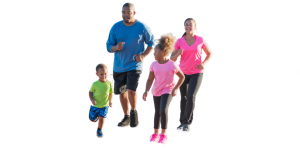One of the best ways to strengthen your bones and prevent osteoporosis is by getting regular exercise. Even if you already have osteoporosis, exercise can help maintain the bone mass you have.
When you exercise, you don’t just build muscle and endurance. You also develop and maintain the amount and thickness of your bones. Health professionals call this “bone mass and density.”
There are three types of exercise for osteoporosis:
- Weight-bearing
- Resistance
- Flexibility
All three types of exercise for osteoporosis are needed to build healthy bones.
Weight-bearing exercise
Weight-bearing means your feet and legs support your body’s weight. A few examples of weight-bearing exercise for osteoporosis are:
- Walking
- Hiking
- Dancing
- Stair climbing
Sports like bicycling and swimming are great for your heart and lungs. However, these are not weight-bearing exercises for osteoporosis as the bicycle or water supports you.
Walking as little as 5 to 8 km a week can help build your bone health. Experts recommend that everyone get at least half an hour of moderate to vigorous exercise five times a week. Forty-five minutes to an hour is even better.
Resistance exercise
Resistance means you’re working against the weight of another object. Resistance helps with osteoporosis because it strengthens muscle and builds bone. Studies have shown that resistance exercise increases bone density and reduces the risk of fractures.
Resistance exercise for osteoporosis includes:
- Free weights or weight machines at home or in the gym
- Resistance tubing comes in a variety of strengths
- Water exercises — any movement done in the water makes your muscles work harder.
For best results, do resistance exercises two or three times a week. Make the exercise more challenging by gradually adding weight or repetitions. Work all your different muscles — including arms, chest, shoulders, legs, stomach, and back. Be sure not to do resistance training on the same muscle group two days in a row. Give each muscle group time to recover.
Flexibility exercise
Flexibility is another form of exercise for osteoporosis. Having flexible joints helps prevent injury.
Examples of flexibility exercise for osteoporosis include these:
- Regular stretches
- Thai chi
- Yoga
Safe exercise for osteoporosis
To ensure your safety during exercise for osteoporosis, keep these guidelines in mind:
- Talk to your doctor before beginning any exercise programme. It is vital if you know you have bone loss or osteoporosis.
- Weight-bearing exercise does not have to be high impact. Running and jumping may put stress on your spine. These high-impact activities may lead to fractures in weakened bones. If you already have bone loss, choose gentler weight-bearing exercises like walking, dancing, low-impact aerobics, and gardening.
- If you already have osteoporosis, be careful of exercises that involve bending and twisting at the waist. This motion can put you at risk of fracture. Activities that involve waist twisting include sit-ups, toe touches, and rowing machines. Golf, tennis, bowling, and some yoga poses also have some twist at the waist. Talk to your doctor before choosing any of these activities.
Sources:












